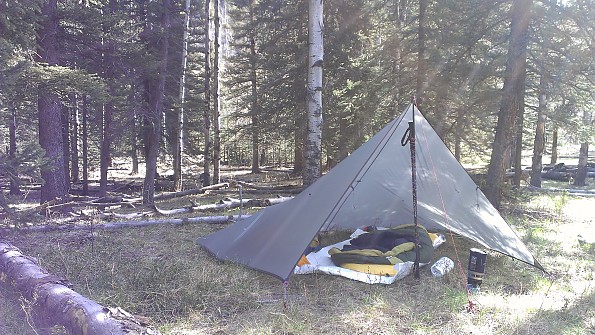Rab Siltarp 2

This tarp has been a great introduction into tarp camping for me. It is much lighter than a conventional tent, as well as being much roomier. There are some tradeoff's though.
Pros
- Super versatile
- Lightweight
- Lots of coverage
- Relatively inexpensive (on sale)
- Great as part of a modular shelter system
Cons
- Difficult to make repairs/modifications
- Heavier than cuben options
- Takes practice to pitch
- Harder to pitch than catenary cut tarps
- No bug protection
- Not free-standing
- Only 3 sides of protection from weather
I have been doing more and more backpacking over the last few seasons. In doing so, I realized that a lot of my kit needed updating. I have a generous family, so I received a new bag and pad for my birthday and didn't have to dish out for a new sleep system. Next on the list was a new shelter...
I had been looking into ultra light tents and hammocking setups. The tents were just too expensive for my recently-out-of-college budget, so that knocked them off the list. Hammocks were a little more reasonable for my budget, since I already owned a hammock and suspension.
There were two things that steered me away from going with a hammock specific setup 1) a good chunk of my backpacking is done for bagging 14ers and I often camp at or just above tree-line 2) a comfortable hammock set up usually requires an underquilt which is more money and more weight. So, I decided to give tarping a try.
I did a good bit of research on the front end (I am a bit of a gear nerd) and decided an 8x10 sil-nylon tarp would be the way to go. Big enough for two, light enough for one. Sil-nylon is light and strong and reasonably priced. I drooled a bit over some cuben fiber options, but the old budget problem reared its head. That is when I found the Rab Siltarp 2 on sale. An 8x10 sil-nylon tarp with lots of tie-out points: 17 to be specific (4 corners, 3 along each edge and one ridgeline loop).
So far, the tarp has been great! Pitching it is nowhere near as mindless as a dedicated pole tent, but for me, that is part of the fun. There are tons of ways to pitch a tarp with trekking poles or trees: lean-to, a-frame, half pyramid, diamond, and many more, plus slight modifications of all of these. You will need to get your own guy-line and stakes. And a good amount of both. I took my cues on how to set up my guylines from an article on inclement weather tarp camping. So far, it has worked out great. I can tie off to trees or rocks, use my trekking poles, and on and on with this set up.
When pitched well (which definitely takes some practice) this tarp pitches taut and impressively stable. The material has a slight stretch to it, which is kind of nice. I have never had a problem with stability in the wind, even though I usually pitch it in windier locations (keeps the bugs down) with my super light carbon trekking poles.
I haven't been out in much precipitation with this tarp yet. But when it has rained a bit, it did well. It is waterproof (you have seam seal the ridgeline yourself) and because you get so much coverage out of it, it is easy to get far enough away from any open ends that you don't get wet. That is one of the down sides about tarps, however: there will always be at least one open end. What this really means is that you have to be smart about setting up your shelter. You don't want to just set it up willy-nilly.
Because a tarp always has at least one side open, there is almost never any problems with condensation. Part of that may be because I am in Colorado, wich is usually pretty dry, but, a tarp does give you options for tons of ventilation.
One of the best things about this tarp is you have tons of room. It is very comfortable for two people plus all their gear, even when pitched tight to the ground for wind/weather protection. It is downright palatial for one.
One of the best parts is that all this room packs down to about the size of a Nalgene and a small stake bag. Just roll up the tarp, use one of your guylines to wrap it up, and you can shove it in your pack. This is really nice for when it is wet, because you can easily strap it to the outside of the pack to keep it from getting all your other gear soggy.
So far, the construction quality seems good. I haven't noticed any fraying and loose threads to speak of. Having so many tie outs on a tarp really makes it easy to lock it down for storm-worthy protection.
I have only spent a handful of nights in this tarp in the back country, but so far it still looks brand new. Hopefully it stands up to all my trips this summer (several over night 14er trips, a few days in the Indian Peaks Wilderness, a few days on the Continental Divide Trail).
Source: bought it new
Price Paid: ~$100 (on sale)
Your Review
Where to Buy
You May Like
Specs
| Price |
Current Retail: $134.95-$170.00 Historic Range: $87.72-$170.00 Reviewers Paid: $100.00 |
| Weight |
393 g / 14 oz |
| Capacity |
2-3 |
| Packed Size |
20 x 10 cm / 7.9 x 3.9 in |
| Dimensions |
305 cm x 244 cm |





